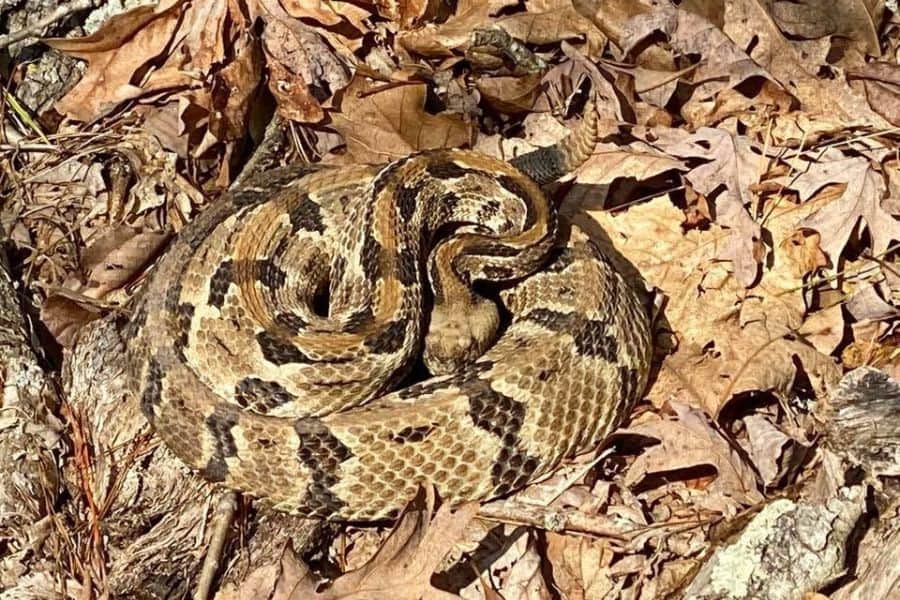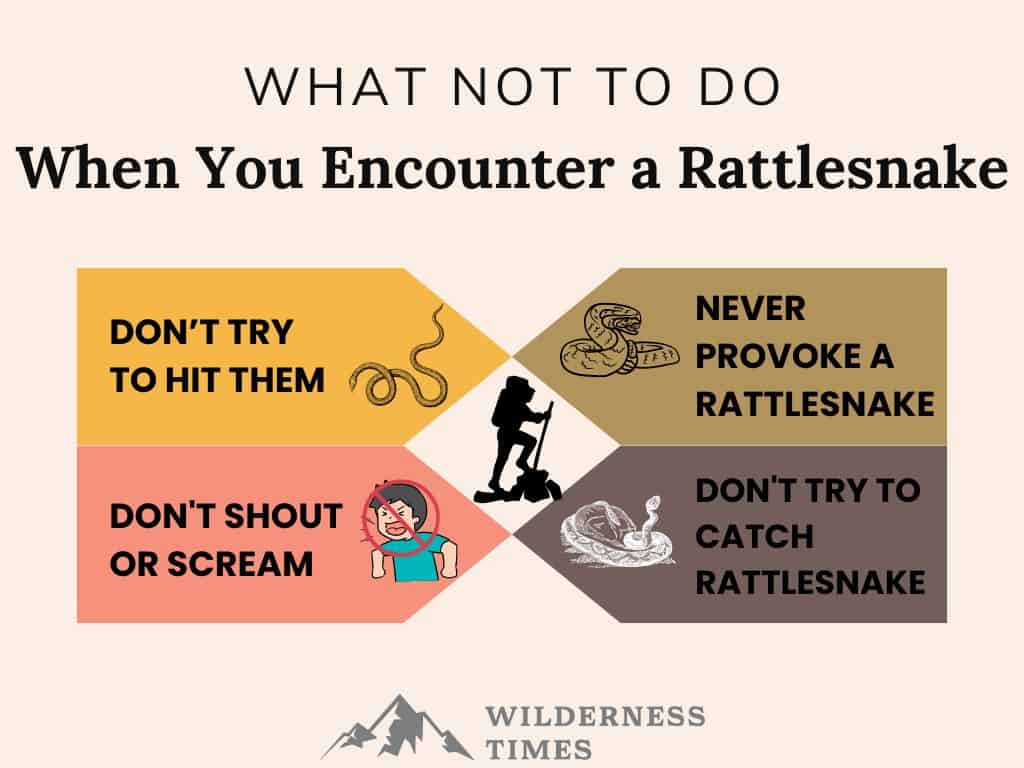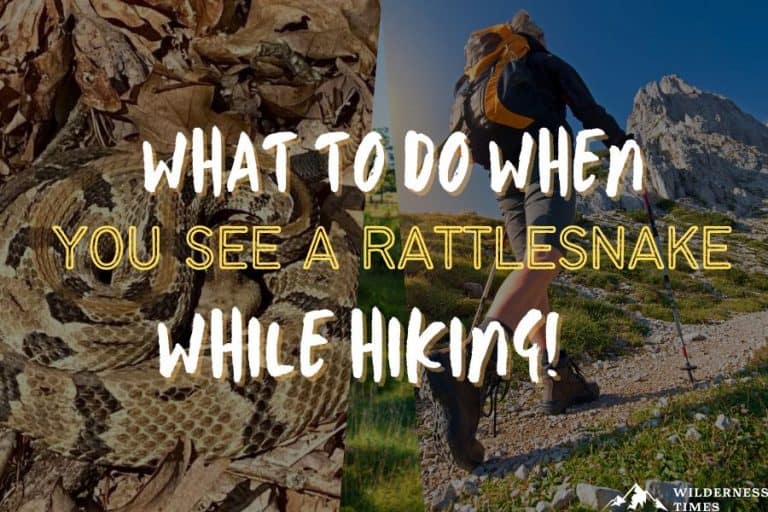Do you know what to do when you see a rattlesnake while hiking?
According to the US Food and Drug Administration, roughly 8,000 people are bitten by rattlesnakes yearly.
Usually, about 10 to 15 bites result in human fatalities. Most fatalities are due to an initial allergic reaction to venom or failure to seek medical treatment in time.
There are over 2,700 species of snakes in the world. Less than one-third of the species are venomous and a threat to humans.
There are more than 25 different species of rattlesnakes in the United States alone.
Snakes are the most persecuted animal in the world. They’re often seen as evil and killed. There are even mass rattlesnake killings perpetrated mainly by religious extremist groups.
And yet, snakes are the single most effective rodent control in the United States alone. Rodents have been known to kill masses through diseases such as Bubonic Plague.
In reality, snakes do cause significant human fatalities through venomous bites. More humans die from bee and wasp stings in a month than from rattlesnake bites for an entire year.
However, a rattlesnake bite is severe and can lead to significant permanent injury to even death if not treated in time.
In my own experience, I have encountered dozens of rattlesnakes while hiking. In most cases, I was hiking to find rattlesnakes because I am a snake watcher.
But most of the time, on regular hikes, I never see rattlesnakes because they generally do what they can to avoid contact with humans.
We’re going to look at how to prevent bites from rattlesnakes and what to do when you see a rattlesnake.
What to Do When You See a Rattlesnake

In most cases, you won’t see a rattlesnake unless you’re trying to find one!
Rattlesnakes do not want to come into contact with humans. They’re more scared of us than we are of them. That makes sense for the simple fact that we dwarf them in size.
Again, I’ve rarely see rattlesnakes unless I’m specifically looking for them.
But in the event of an actual encounter, it’s good to know what to do when you see a rattlesnake.
- In most cases, the snake will start rattling.
- You may hear the rattle before you even see the snake.
- If you hear it, stop and hold still.
- Then start looking for where the rattling sound is coming from. *But note that not all rattlesnakes will rattle before biting, especially if you come into physical contact with the snake, such as stepping on it by accident.
- Once you spot a rattlesnake, watch closely to see what it’s trying to do.
- If it’s moving, hold still and let it move to where it wants to go.
- If it’s curling up, it is getting into a defensive position and will be ready to strike if provoked. At that point, you should move away from it, giving it plenty of room not to feel threatened by your presence.
Always give the snake plenty of space and enough room for egress.
Many rattlesnakes will attempt to flee, and some can move fast. It is best not to get in the way of it doing that.
Read: Hiking Safety Tips
How to Recognize a Rattlesnake

Rattlesnakes are pretty easy to recognize.
Mostly, they have rattles and no other snake, but a rattlesnake has a rattle. But I did say “for the most part” because not all rattlesnakes have a rattle!
Young rattlesnakes don’t usually develop a rattle until they age and shed a few times. Some rattlesnakes will get into situations where their rattle breaks off.
Most rattlesnakes you see will have a rattle aside from the neonate (baby) ones.
But most snakes, venomous and non-venomous, will rattle their tail as a sign of defensive warning, especially when encountering us humans.
Because of this, many people mistake regular snakes for rattlesnakes.
Most rattlesnakes will gain an extra segment of their rattle in every shed. Snakes tend to shed two or three times a year.
This can help you age a snake but isn’t always considered entirely accurate in the herpetology world.
Rattlesnakes will have different features and colorations than other non-venomous snakes.
It’s a good idea to study the different species of rattlesnakes in your area and get a feel and memory of what they look like.
Rattlesnakes will have elliptical pupils like a cat. They have large diamond-shaped heads caused by the venom glands behind their eyes.
Non-venomous snakes will flatten out their heads and bodies to mimic venomous snakes when they feel threatened. The non-elliptical eyes are a dead giveaway though they are not venomous.
At the end of the day, if you get bit by a snake in the wild, you should assume it’s venomous if you don’t know for sure.
How to Avoid Rattlesnake Encounters While Hiking
The number one tip for avoiding rattlesnake encounters while hiking is always to watch where you take your next step.
But there are even more ways to avoid rattlesnake encounters that you can practice and turn into a habit.
Know the snake migration periods. Snakes usually migrate into hibernation around fall when it gets cooler at night and during the day.
Snakes are generally hibernating during the winter. Snakes will typically come back out when spring and warmer weather arrive.
You can avoid most snake encounters by staying on well-used designated trails. Going off the beaten path will increase your chances of seeing snakes.
Hiking with trekking poles can also help, mainly if you use them to poke around where you plan to step next.
You should also be careful when climbing rocks and gathering firewood. Watch where you put your hands.
In my experience, though, the number one thing you need to do is watch your next step.
I have avoided more negative snake encounters than I can count by simply watching where I am stepping.
What NOT to Do When You Encounter a Rattlesnake

The most important thing NOT to do when encountering a rattlesnake is to run away from it.
You’ll put yourself in danger of encountering more snakes you don’t see because you’re panicking and running.
If you see a rattlesnake, take a deep breath and realize that you are a hundred times its size. You can walk faster than it can slither.
There is no need for you to run.
But there are other things you shouldn’t do when encountering rattlesnakes, too!
Don’t try to hit them or wave things at them
They’ll see it as a threat, and they may potentially strike. An adult rattlesnake can usually strike at a distance of about the length of its body.
It takes a lot to get most rattlesnakes to strike but trying to hit it will make them do it.
Shouting and screaming at any snake will do nothing for you
Snakes are not known to hear things. They may feel vibrations that give them a similar sense, but they are unaware of what you’re saying.
So, screaming at a snake will usually result in the snake being unphased.
Provoking a rattlesnake is the worst thing you can do
Rattlesnakes are typically one of the calmer species of venomous snakes. But they’re also usually more toxic than most venomous snakes.
Provoking one could result in a bite with venom injection. Getting bit by a rattlesnake could mean permanent severe injuries to even death.
What to Do if a Rattlesnake Bites You

If a rattlesnake bites you or someone who is with you, the main thing that needs to happen is that the bite victim receives emergency medical treatment.
Get the victim to a hospital or emergency medical personnel as soon as possible. Call 911 if you can, or get somewhere with enough signal if you’re in a bad phone signal area.
The later the victim receives medical attention, the more severe the outcome can be.
Many venomous snake bite victims might also have an initial allergic reaction to the bite. This could include hive breakouts, itching, and unusual swelling.
Asphyxiation from an allergic reaction is also possible. Anti-histamine (such as Benadryl) or an epi-pen may be an effective life-saving action at this point.
If you can, clean the area where the bite occurred and cover it lightly with a bandage. You should not compress the area where the bite occurred.
Try to keep the bite area below the heart as much as possible.
As the area will likely swell, remove any clothing, rings, bracelets, and other jewelry from the victim.
Many bites from venomous snakes are dry bites. This means that the snake does not inject venom into you when it bites.
The snake knows it can’t eat you, and regaining its venom after a bite takes a toll on the snake.
Because of that, the snake may dry its bite. But you should always assume the bite injected venom into you.
The good news is that most hospitals carry anti-venom, usually made from horses. The anti-venom will likely have side effects, but it can be very lifesaving if needed.
The chances of a snake bite from a rattlesnake becoming fatal is 1 in 600. You have a better chance of surviving if you respond accordingly.
What NOT to Do if a Rattlesnake Bites You
There are many myths when it comes to getting bit by a rattlesnake.
One of the biggest ones is that you should kill the snake and bring it with you so medical professionals can quickly identify it.
Doing this could get you bitten and more venom injected into you. The more venom that goes into you, the more likely you will have permanent damage or even die from the bite.
Don’t attempt to capture or kill the snake
Leave it be and let it do what it wants while you focus on getting medical assistance.
Panicking is also a bad idea
It can cause the venom to spread quickly and cause other adverse reactions in the victim. Panicking will not help the situation.
Don’t elevate the bite above the heart or put compression around the wound
Doing these things will cause the venom to spread out quickly.
Do not attempt to cut on the bite area, suck the venom out, or use a snake bite kit
Snake bite kits have been proven to be ineffective by medical professionals. Some argue they do more damage than what is needed.
Don’t assume it wasn’t a venomous bite
Not treating a venomous snake bite can result in amputation, serious health problems, permanent medical conditions, and even death.
Areas Where Rattlesnakes Can Be Found

Rattlesnakes are often displayed in the deserts of the western United States.
But in reality, they’re almost in every state in the US.
You’ll find rattlesnakes from all the way from southern Canada to the lower 48 states, all the way to central Argentina.
Only Alaska and Hawaii are exempt from rattlesnakes.
In the state I live in, Illinois, we have two species of rattlesnakes. We have the Timber Rattlesnake, commonly found in the state’s southern portion.
We also have the Massasauga Rattlesnake, a very low-population pigmy rattlesnake species located in one protected area in the northern part of Southern Illinois.
While many rattlesnakes out west can thrive in the desert, many in non-desert states are in the woods.
Our timber rattlesnakes, for example, are found in the Shawnee National Forest mainly in hardwood forests around bluffs and outcroppings.
We also have a road that closes two times a year for an annual snake migration. That area comprises swamps on one side of the road and bluffs on the other.
That area is a thriving timber rattlesnake occurrence area.
In most cases, you’ll find rattlesnakes anywhere where the climate becomes warmer at some point.
During cooler temperatures, the snakes will perform a specific type of hibernation.
In most cases, rattlesnakes are not found in colder climate states such as Alaska or Maine.
Too much cold is too much for a snake. Snakes enjoy the heat as we humans do.
Rattlesnake Frequently Asked Questions

You might have many questions concerning rattlesnakes. Below is a compiled list of some of the most frequently asked questions about these animals.
Do Rattlesnakes Attack People?
No. Rattlesnakes nor any other wildlife do not attack humans. They may, however, become defensive when stepped on or if they feel threatened.
It isn’t attacking if you’re defending yourself from harm – we do the same thing as humans. If a rattlesnake coils up and starts rattling, it tells you to leave it alone, or it will defend itself.
You can leave the snake alone and walk away from it, and that’s all you have to do.
Will a Rattlesnake Chase You?
No. Snakes don’t chase people. That is a common myth created many years ago. Some snakes (such as the racer) will mimic people’s actions.
So, if you run in one direction, the same may slither quickly in the same direction.
Other theories suggest that snakes that appear to chase people were planning to flee in that direction.
The only reason a snake would have to pursue something is for feeding. A snake knows that it can’t eat something as large as a human.
Should I be concerned about a mother rattlesnake if I find a baby?
No. Snakes are not paternal. Once a snake gives birth, it will usually abandon its young. Snake babies are immediately instinctual to their nature and abilities.
They do not go through a child-like stage like that of a fawn or a bear cub. Some snakes may stay around the babies for a small amount of time to rest, but they quickly leave their young to fend for themselves shortly after.
Some rattlesnakes will leave a scent trail for the neonate snakes to follow to get them toward an environment where they can thrive better.
Will All Rattlesnakes Rattle Before They Bite?
No. Most of the time, if a rattlesnake sees you before you come into physical contact with them, it will start to rattle.
However, if you surprise them, they might strike before rattling as a defensive reaction. Stepping on a rattlesnake will likely result in a strike before rattling.
Some rattlesnakes will not rattle as you walk by because they are attempting to be still and not seen by you.
They may assume you don’t see them, so they stay still because of that. Rattlesnakes do not want to have an encounter with you.
Do Rattlesnakes Hibernate?
Yes. Rattlesnakes typically hibernate during the fall and winter months. They will usually move into holes in deep rocks such as mountains and bluffs in the fall when the days and nights become cooler.
They typically emerge in the spring when it begins to get warmer during the day and night. Snakes hibernate in a process called brumation.
This is where the snake will stop eating, and its heart and respiratory rates will slow down significantly. It is almost as if they’re in a suspended animation process.
The animal is awake most of the time but very inactive. Scientists say that this process strengthens the lifespan of the animal.
At times, some snakes will emerge during winter days with plentiful sunshine, but they won’t stay out long or get too far from their den.
How Toxic are Rattlesnakes?
It depends. Rattlesnakes out west (desert states) and south of the Ohio River typically have neurotoxicity in their venom.
In the Midwest, north of the Ohio River, rattlesnakes are usually hemotoxic in venom.
One toxicity does a different kind of damage to living tissue than the other, but they are both severe enough to be concerned about.
Neurotoxic venom will attack the central nervous system of the bite host. This can cause paralysis, strokes, brain problems, and quicker fatalities if not treated promptly.
Hemotoxic venom attacks blood cells. This venom can lead to amputation requirements, heart problems, and death if not treated quickly.
A venomous bite from a rattlesnake is serious, no matter the type of toxicity of the venom.
Should I Kill Rattlesnakes When I See Them?
No. In most states, rattlesnakes have protected status. In all public lands, it is unlawful to harass, harm, or kill a rattlesnake unless your life is in immediate danger.
Snakes get a bad rep. And most of it is due to generational myths and religious extremism. But in reality, snakes do more good than they do bad.
Venomous snakes have been used for medical and lifesaving treatments around the world. Snakes control the rodent population.
On average, a dog will kill more humans in a month than a snake in a year. If we were to go around trying to kill all dogs, there would be a public outcry.
But why is there not one with snakes?
How could I help protect snakes?
You can help protect snakes by learning more about them. Then take what you have learned and educate others about them.
More people are needed to dispel the myths and conspiracy theories about snakes. Humans and snakes have been able to co-exist for all of humanity.
However, snakes are starting to decrease in numbers, resulting in less rodent control and harm to the natural balance in nature.
This will only threaten the existence of humans in years to come. We need snakes, and snakes need us.
To Sum It Up
Knowing what to do when you see a rattlesnake is essential. But it is just as important to understand what these animals are, where they live, how they behave, and the risks associated with them.
The information above explains almost everything you’d need to know about a rattlesnake and how to avoid a bite from one.
They’re no different from any other wildlife you may encounter while recreating outdoors.


